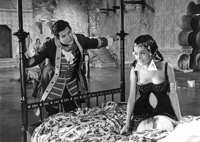tytuł oryginalny: Rękopis znaleziony w Saragossie / The Saragossa Manuscript
reżyseria: Wojciech Jerzy Has
występują: Zbigniew Cybulski, Iga Cembrzyńska, Elżbieta Czyżewska, Gustaw Holoubek
kraj i rok produkcji: Polska 1964
czas trwania: 182'
data premiery: 1965-02-09
original language: Polish with English subtitles

Jeden z najbardziej niezwykłych polskich filmów kostiumowych. Przedziwne perypetie Alfonsa van Wordena podczas jego podróży do Madrytu, gdzie ma objąć służbę w gwardii walońskiej, są okazją do opowiadania – przez spotykane przez niego postaci – kolejnych intrygujących historii. Bohater kilkakrotnie w zagadkowy sposób powraca do punktu wyjścia – tajemniczej karczmy i jej upiornego otoczenia, by ponownie wyruszać w znane mu czasy i przestrzenie, jednak za każdym razem wypełnione innymi postaciami i widziane z innej perspektywy.
Jest to adaptacja XIX-wiecznej powieści Jana Nepomucena Potockiego, dzieła o losach równie skomplikowanych, co opowiedziana w nim historia, opublikowanym ponad 140 lat po śmierci autora. Jest jednym z najciekawszych przykładów narracji szkatułkowej, w której jedna historia prowadzi do drugiej, a z kolei ta do kolejnych, a wszystkie razem tworzą pełen obraz fabuły. Film Hasa został wyróżniony na zagranicznych festiwalach i zdobył uznanie w wielu krajach. Podobnie, jak jego literacki pierwowzór, przez dziesięciolecia krążył po świecie w różnych skróconych wersjach, aż w 1997 roku, z inicjatywy Martina Scorsese i Francisa Forda Coppoli, zrekonstruowano jego pełną wersję i zaprezentowano ją zachodniej publiczności.
Alfons van Worden (Z. Cybulski), a young captain of the Spanish king's guard, travels through the Sierra Morena mountains. Two Moorish princesses, met on the way in an inn, make him aware of his origin. The girls turn out to be Worden’s cousins. As a descendant of the powerful Gomelez family, he should be up for a serious task. It will be possible when he finds himself in the castle of the mysterious Kabbalist. An adaptation of the novel by Jan Potocki, an 18th-century poet, philosopher and traveler, first published in French in 1813. It has a Chinese box structure – one story contains the second one, it contains one another one… The titular manuscript (rękopis) distracts two enemy army captains from the warfare and draws them into reading amazing stories. The then Spain was staged in the Cracow-Częstochowa Upland, the oriental atmosphere of the film is largely due to the talent of scenographer Jerzy Skarżyński, the director's regular collaborator. The film is Wojciech Jerzy Has's magnum opus, a piece matching his imagination and talent, it also surpasses the then productions of Polish cinema. The film was created in the "Kamera" Film Studio, headed by Jerzy Bossak. The film won the CIDALC award and the Journalists’ Golden Pen at the San Sebastian International Film Festival. What is more, it won an honorable mention in Edinburgh and a special medal in Stiges at the festival of fantasy and horror films. The monthly "Film" honored the film with the Golden Duck on the occasion of the magazine's 60th anniversary (2006). The list of awards does not reflect the cult status of the production abroad. None of the Polish films, despite their cult status in the country, has achieved something similar in the world. The film created by Has is the only exception.